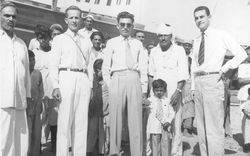Amerikanizm
Jean-Louis Cohen presents a brief history of the idealized representations of America that shaped modern Russia
“There are now two great nations in the world which, starting from different points, seem to be advancing toward the same goal: the Russians and the Anglo-Americans. Both have grown in obscurity, and while the world’s attention was occupied elsewhere, they have suddenly taken their place among the leading nations, making the world take note of their birth and of their greatness almost at the same instant…One has freedom as the principal means of action; the other has servitude…Their point of departure is different and their paths diverse; nevertheless, each seems called by some secret desire of Providence one day to hold in its hands the destinies of half the world.”
Alexis de Tocqueville, Democracy in America, 18351
Alexis de Tocqueville’s memorable prophecy described a rivalry that persisted until the end of the twentieth century, sealing the fate of both nations in the political, economic, and cultural spheres. Architecture stood at the heart of this often-contentious relationship, both as a symptom and as its monumental expression. In the context of industrialization and modernization, the transformations undergone by this discipline were determined by an American ideal that could be reductively described as a skyscraper fetish, which was its most apparent manifestation. This ideal has shaped German, British, French, and Japanese architectural cultures, but nowhere has it been as powerful and wide-ranging as in Russia over the past two centuries.
Despite China’s recovery of its formerly long-held power, the American-Russian enmity has survived to the collapse of the Soviet Union, as evidenced by Vladimir Putin’s attempts to undermine the American political system. In the second half of the 19th century, the conflictual relationship between the two ideologies had already shaped the divide that would come to characterize the global balance. As in other fields, the developing relationship between Russia and the United States played out in the realm of architecture, understood as widely as possible and with respect to its connections to urban planning, landscaping, and design. In the 1960s, this “parallel history” of two nations inspired the French writers Louis Aragon and André Maurois to write an eponymous monumental work about the confrontation set during the post-war era.2
But the opponents of this geopolitical duel, depicted in the evocative 1968 collage “Superman CCCP / USA” by the Polish artist Roman Cieslewicz, were of unequal strength, contrary to what this illustration would have you believe.3 The USSR, defeated in the Cold War, was heavily dependent on America. Both socialist and capitalist Russia’s fascination with the United States was multifaceted, enduring, and complex, and extended far beyond the architectural sphere discussed within these pages. Consistent with the overall workings of Americanism, this fascination offers a somewhat distorted view, deforming certain traits of a phenomenon that can only be understood by examining the network of relations between Russia and the West at large, as well as America’s ties with the rest of the world.
Modernity and Americanism
A brief history of what I will refer to as Americanism is in order. The term was coined in 1781 by the Scottish minister John Witherspoon, the sixth president of Princeton University, to describe certain aspects of the English spoken in the United States.4 Thomas Jefferson expanded its meaning to characterize the new nation’s political principles.5 Some decades later, the word came to denote reception, when Pierre Larousse defined it in his Dictionnaire universel as the “pronounced and exclusive admiration for the government, laws, and usages of the Americans, principally the inhabitants of the United States,” which he distinguished from “Américanomanie,” the “affected, ridiculous admiration for everything associated with America.”6 As for Baudelaire, he was mostly referencing the prosaic aspect of the notion when he wrote of Edgar Allan Poe that “the day that he wrote, ‘All certainty is dreams,’ he thrust back his own Americanism into the region of inferior things.”7 Without necessarily endorsing this critical stance, several nineteenth-century thinkers incorporated America in their worldview. Goethe, in his 1827 poem “America,” praised the benefits of a nation free from the weight of the past:
“America, you are better off
Than our ancient continent.
You have no tumbledown castles
And no basalt deposits.
Your inner lives are not disturbed by
Useless memories and vain strife.”8
By contrast, Hegel, in his 1830 Lectures on the History of Philosophy, considered that “this part of the world already belonged to the past when it came into contact with us, and it wasn’t yet ready to play its part in history.”9 Karl Marx similarly disagreed with Goethe’s point of view, which made America a “new world” cut off from the old one. His colleague Friedrich Engels, after briefly travelling across the Atlantic in 1888, was most cautious: “We usually think of America as a new world, new not merely because of when it was discovered, but new in all its institutions—a world far ahead of us old-fashioned sleepy Europeans, with its disdain for everything traditional, handed down from the past, a world entirely built anew on virgin soil by modern people and founded on modern, practical, rational principles.”10 On the contrary, he observed the old-fashioned aspect of American cities and material culture. Like Marx, he supported the Union during the Civil War. As for Nietzsche, in The Joyful Wisdom, he compared the Americans to fifth-century Athenians, describing “the American conviction of the present day, which wants also more and more to become a European conviction: whereby the individual is convinced that he can do almost anything, that he can play almost any role, whereby everyone makes experiments with himself, improvises, tries anew, tries with delight, whereby all nature ceases and becomes art.”11
As the Russians’ understanding of the United States grew more substantial, through writings, reports, and exhibitions visited by the masses, the “American scene”—as Henry James called it, while cautiously keeping it at a distance12—began to foreshadow what the future held for Europe. This was especially true as World War I allowed the United States to gain a firm foothold in a battered European economy. According to its leader George Creel, the Committee on Public Information, created in 1917 by President Woodrow Wilson to support the war effort, preached “the Gospel of Americanism.”13 In 1928, the Spenglerian book This American World by the foreign correspondent Edgar Ansel Mowrer, then stationed between Rome and Berlin, was translated in German under the eloquent title Amerika, Vorbild und Warnung [America, Example and Warning]14. In his preface to the original edition, T. S. Eliot noted that “the literature of Americanism…ha[d] been steadily accumulating.”15 In the years after the war, examples of this propagation could be found even in the most revolutionary texts. One of the subtlest critics of Americanism was the Italian communist leader Antonio Gramsci, who was familiar with Ford’s industrial policy, as it had been replicated by Fiat. In a 1934 entry of his prison notebooks on “Americanism and Fordism,” he examined the principles behind the American industrial doctrines and their effects, based on Trotsky’s writings, among others.16 The latter had indeed declared to an American senator, in 1923, that “[t]he words ‘Americanism’ and ‘Americanization’ are used in our newspapers and technical journals in an altogether sympathetic way and by no means in the sense of reproach.”17
The Unique Case of Russia
This sympathy was not solely the result of the 1917 revolution, as a form of Russian Amerikanizm was already becoming apparent by the end of the nineteenth century. According to Hans Rogger, “Americanism was both a perception of the United States as an industrial civilization from which more could and should be learned or borrowed than mere isolated techniques or pieces of equipment, and the acceptance of the inevitability of doing so and of Russia’s becoming more like America in the process.”18 The semantic field around the notion was particularly broad. As opposed to Americanism, which mainly concerned ideas and representations, Americanization—Amerikanisierung in Germany and amerikanizatsia in Russia—, which was often confused with it, became commonly used as of 1918.19 It described the direct presence of capital and American operatives in material or cultural production, two manifestations whose timeframes often collided, but not necessarily so. These two neutral aspects went hand in hand with their morbid and grotesque expressions, identified early on in the Soviet Union, as though to prove Larousse right several years later: an “amerikanshchina” [Americanite], a childhood illness of Soviet cinema, was diagnosed as of 1922 by the filmmaker Lev Kuleshov.20
The film industry played a major part in the phenomenon, not only because Hollywood was central in global film production, but also because its spectacular nature was part of the essence of Americanism. In one of the most popular works of interwar fiction, the French novelist Georges Duhamel, a critic of American mass entertainment, described “scenes from the life of the future” as he perceived them in American society.21 More than theatre or cinema, phantasmagoria seems to be medium through which the New World appeared to the eyes of the old one. Characters, products, and buildings emerged as apparitions, much like in Walter Benjamin’s analysis of the nineteenth-century Parisian spectacle of consumerism. Like the great industrial-age displays, these spectres—appearing in print, in photographs, on screens, or in three dimensions, in the case of exhibits—conveyed an ideology of progress associated with America and carrying the promise of happiness. These visions, as much as the reality of production and construction, sang the praises of Americanism. Construction site mystique, as imagined in the late 1920s Soviet Union, was embodied by a ghostly ballet of workers and engineers set against a backdrop of cranes, drawbridges, and machines. Later, Broadway’s nocturnal spectacle rolled out the screen onto which Moscow’s Stalin-era “seven sisters” were projected.
The particular pervasiveness of the Americanist phantasmagoria in Russia derived from the identification between the “two great nations” suggested by Tocqueville and revisited by Walt Whitman as he called for a Russian publication of his Leaves of Grass: “You Russians and we Americans;—our countries so distant, so unlike at first glance—such a difference in social and political conditions, and our respective methods of moral and practical development the last hundred years;—and yet in certain features, and vastest ones, so resembling each other. The variety of stock-elements and tongues to be resolutely fused in a common Identity and Union at all hazards—the idea, perennial through the ages, that they both have their historic and divine mission—the fervent element of manly friendship throughout the whole people, surpassed by no other races—the grand expanse of territorial limits and boundaries—the unformed and nebulous state of many things, not yet permanently settled, but agreed on all hands to be the preparations of an infinitely greater future—the fact that both peoples have their independent and leading positions to hold, keep, and if necessary fight for, against the rest of the world—the deathless aspirations at the inmost centre of each great community, so vehement, so mysterious, so abysmic—are certainly features you Russians and we Americans possess in common.”22
Nevertheless, the parallel drawn by Tocqueville and Whitman did not describe symmetrical attitudes. Though many authors saw Russia as a “new America”—and though the Bolsheviks intended, according to the Russian lyrics to the Internationale, to build a “New World,” which would actually be a new “new world,” more perfect than the first one—, even the strongest American supporters of the Soviet Union never imagined creating a “new Russia” between the Atlantic and Pacific oceans. And while there was no symmetry between the two positions, the Russian stance was far from monolithic. Americanism and anti-Americanism incessantly combined and conflicted as of the mid-nineteenth century among writers, ideologists, and politicians. Critical accounts of racial segregation in the South and of the supremacy of money in the North echoed the general exaltation of civil liberties. Maxim Gorky’s damning indictment after his 1906 trip is a perfect example of this critical discourse. A terrifying phantasmagoria alternated with the naïvely optimistic one depicting the wonders of America.
The opposition between a static European civilization and a dynamic American industrial culture was a constant in writings about America by intellectuals who either visited the country themselves or drew on second-hand accounts. This dichotomy was largely accepted in the 1920s, as one of the most popular works in Soviet publishing was Oswald Spengler’s Decline of the West. The book was discussed in Russia as of 1921, by the philosopher Nikolay Berdyaev, among others, and translated in 1922.23 Writing in a tone meant to bring solace, Spengler noted, much to his readers’ outrage, that Russia would avoid the decline because it was not part of Europe.
This text is an excerpt from the introduction to Jean-Louis Cohen’s Building a new New World: Amerikanizm in Russian Architecture, published on the occasion of our exhibition in the Main galleries.
Alexis de Tocqueville, De la démocratie en Amérique [1835] (Paris: Pagnerre, 1848), 413-414.
Louis Aragon and André Maurois, Les deux géants : histoire des États-Unis et de l’URSS, de 1917 à nos jours, (Paris: Éditions du Pont Royal, 1964).
Roman Cieslewicz, “Les deux Superman,” Opus international, no. 4 (1967): cover.
John Witherspoon, The Works of the Rev. John Witherspoon, (Philadelphia: William W. Woodward, 1801), 4 and 182.
He evokes principles of “pure americanism” in a lettre to Edward Rutledge, 24 June 1797, in The Works of Thomas Jefferson, vol. 8, Paul Leicester Ford, ed. (New York City: G. P. Putnam’s Sons, 1904), 316.
Pierre Larousse, Grand dictionnaire universel du XIXe siècle, vol. 1 (Paris: Administration du Grand dictionnaire universel, 1866): 262.
Charles Baudelaire, “Notes nouvelles sur Edgar Poe,” in Edgar Allan Poe, Nouvelles histoires extraordinaires [1857] (Paris: Michel Lévy, 1875), x.
J. W. von Goethe, Goethes Werke (Hamburg: Wegner, 1952), 333; translated in Jean Nurdin, Le rêve européen des penseurs allemands (1700-1950) (Lille: Presses universitaires du Septentrion, 2003), 65.
G. W. F. Hegel, Leçons sur la philosophie de l’histoire [1830] (Paris: Gallimard, 1993), 230-242, cited in Vincent Bontems, “L’Amérique… selon Marx,” Cahiers d’histoire. Revue d’histoire critique, no. 103 (2008): 130-144.
Friedrich Engels, in Friedrich Engels and Karl Marx, Letters to Americans, 1848-95: A Selection (New York City: International Publishers, 1963), 291, cited in Vincent Bontems, “L’Amérique… selon Marx”: 133.
Friedrich Nietzsche, Le gai savoir [1882], Henri Albert, trans. (Paris: Le Mercure de France, 1887), 194.
Henry James, La scène américaine [1907] (Paris: Éditions de la Différence, 1993).
Emily S. Rosenberg, Spreading the American Dream: American Economic and Cultural Expansion, 1890-1945 (New York City: Hill and Wang, 1982), 108.
Edgar A. Mowrer, Amerika, Vorbild und Warnung (Berlin: Rohwolt, 1928).
T. S. Eliot, preface to Edgar A. Mowrer, This American World (London: Faber and Gwyer, 1928), ix.
Antonio Gramsci, “Américanisme et fordisme” [1934], in Cahiers de prison, Claude Perrus, trans. (Paris: Gallimard, 1991), 175-213.
Léon Trotski in Jeffrey Brooks, Thank You, Comrade Stalin! Soviet Public Culture from Revolution to Cold War (Princeton: Princeton University Press, 2000): 37.
Hans Rogger, “Americanism and the Economic Development of Russia,” Journal of the Society for Comparative Study of Society and History 23, no. 3 (July 1981): 407.
See for example Pierre Musso, “Américanisme et américanisation: du fordisme à l’hollywoodisme,” Quaderni, nos. 50-51 (2003): 231-247.
Lev Koulechov, “Amerikanchtchina,” Kino-fot 1, no. 1 (1922): 14-15.
Georges Duhamel, Scènes de la vie future (Paris: Mercure de France, 1930).
Walt Whitman, letter to John Fitzgerald Lee, 20 December 1881, in Walt Whitman, The Correspondence, vol. III, 1876-1885 (New York City: New York University Press, 1969), 259, cited in Alan M. Ball, Imagining America: Influence and Images in Twentieth-century Russia (London: Rowman & Littlefield, 2003), 15.
Oswald Spengler, Der Untergang des Abendlandes, vol. 1, Umrisse einer Morphologie der Weltgeschichte: Gestalt und Wirklichkeit (Munich: Braumüller, 1921); and vol. 2, Welthistorische Perspektiven (Munich: C. H. Beck, 1922). On Spengler’s reception in the USSR, see: Carol Avins, Border Crossings: The West and Russian Identity in Soviet Literature 1917-1934 (Berkeley: University of California Press, 1983), 36-37.
Maria Gough aptly pointed this out in Maria Gough, The Artist as Producer: Russian Constructivism in Revolution (Berkeley: University of California Press, 2014), 132–136.












































